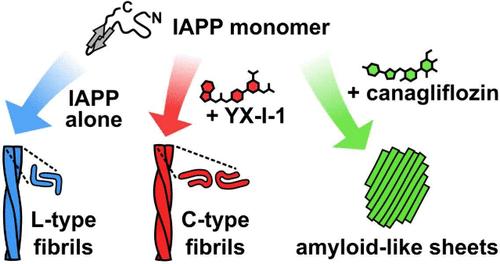Kinetic Steering of Amyloid Formation and Polymorphism by Canagliflozin, a Type-2 Diabetes Drug
IF 14.4
1区 化学
Q1 CHEMISTRY, MULTIDISCIPLINARY
引用次数: 0
Abstract
Amyloid formation is involved in widespread health conditions such as Alzheimer’s disease, Parkinson’s disease, and type-2 diabetes. Amyloid fibrils have a similar cross-β architecture, but fibrils formed by a single protein sequence can have diverse structures, varying with time, self-assembly conditions, and sequence modifications. Fibril structure has been proposed to be diagnostic of disease, but why different structures result under different conditions, especially in vitro, remains elusive. We previously identified a small molecule, YX-I-1, which inhibits in vitro amyloid formation by islet amyloid polypeptide (IAPP), a peptide hormone whose amyloid formation is involved in type-2 diabetes. Here, using YX-I-1 as a lead, we identified regulator-approved drugs with similar structures by chemical similarity analysis and substructure searches and monitored the effect of 24 of these potential ligands on IAPP amyloid assembly in vitro. We show that one such compound, canagliflozin (Invokana), a type-2 diabetes drug already in clinical use, can strongly delay the kinetics of IAPP amyloid formation, an activity independent of its intended mode of action [sodium-glucose linked transporter 2 (SGLT2) inhibitor] that may have important therapeutic implications. Combining analysis of amyloid self-assembly kinetics, biophysical characterization of monomer and fibril binding, and cryo-EM of the assembly products, we show that YX-I-1 and canagliflozin target IAPP early in aggregation, remodeling the energy landscape of primary nucleation and profoundly altering the resulting fibril structures. Early binding events thus imprint long-lasting effects on the amyloid structures that form.

求助全文
约1分钟内获得全文
求助全文
来源期刊
CiteScore
24.40
自引率
6.00%
发文量
2398
审稿时长
1.6 months
期刊介绍:
The flagship journal of the American Chemical Society, known as the Journal of the American Chemical Society (JACS), has been a prestigious publication since its establishment in 1879. It holds a preeminent position in the field of chemistry and related interdisciplinary sciences. JACS is committed to disseminating cutting-edge research papers, covering a wide range of topics, and encompasses approximately 19,000 pages of Articles, Communications, and Perspectives annually. With a weekly publication frequency, JACS plays a vital role in advancing the field of chemistry by providing essential research.

 求助内容:
求助内容: 应助结果提醒方式:
应助结果提醒方式:


